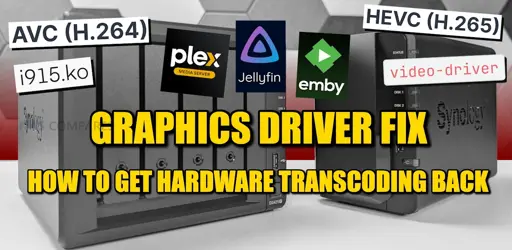Synology’s 2025 refresh brought the DS225+ and DS425+ with the familiar Intel Celeron J4125, but it also quietly removed the kernel graphics driver support that Plex, Jellyfin, and Emby use for hardware transcoding of H.264 and HEVC. This guide explains what changed, why it matters for real-world streaming, and how you can restore GPU-accelerated transcoding on these models using an unofficial SSH method shared by the community. If you rely on your NAS to reshape 4K or high bitrate files for phones, tablets, hotel TVs, or limited connections, this walkthrough will help you get that efficiency back.



Are there any great alternatives that are easy to use off the shelf (with our own drives) that can compete here?
I’m basically to the point where my next NAS will end up just being a linux desktop running truenas which sounds like a lot of tinkering for something that should have a simple solution. I don’t want to have to buy some big expensive enterprise array for a prosumer use case.
TrueNAS. More control for slightly more work up front. Hardware will be easier to maintain. Lots of gamer desktops that won’t run Win11 available that probably have enough SATA ports to get the job done.
Gamer desktops tend to be power hogs. Running them 24/7 can rack up some hefty power bills, plus noise, plus space, plus other tradeoffs.
Better a used thin client.
A thin client for a NAS? That’s a hard no for me. Take the GPU out if you don’t need it, put a more efficient PSU and it will sip power as long as you aren’t running 27 virtual machines on it. I guess it’s more space than a thin client, but I have no idea how you are getting multiple HDDs or SSDs in a tc. USB is trash at long term data storage, and having a bunch of external drives and cables isn’t superior to a slightly bigger box. Not to mention anything that’s actually sold as a thin client probably won’t run ZFS very well if at all. If it’s not ZFS and it’s not hardware raid what the hell is the point of having network storage? Save the TC for a docker host or host a VM on your NAS that it can connect to instead.
https://xpenology.org/
Stuff like that puts me off. By default it’s basically illegal, so we have no idea when the developers will need to retain legal counsel that explicitly tells them to delete everything and cease discussing it.
Support and maintenance are a nightmare, and based on the other folks here talking about it, it’s certainly something to have to tinker with heavily.
If i’m going to have to tinker, i’m going to go with FOSS stuff if I can. I’d rather learn something that will be useful for a while.
I use Xpenology on an HP Gen 8 microswrver, a pretty nifty piece of kit. Works great, but setting up and upgrading versions can be a rather involved process.
My next nas wont be synology, it will be qnap.
I’d recommend against it. It works “fine” but everything is in a thin, but walled, garden. Every app is some “Qsomebullshit.” They really, really want you in their ecosystem.
Id say the systems are underspec’ed as well. The model I bought years ago pitched itself as VM/container ready, but the chipset was so weak it couldn’t run anything worth a damn. It couldn’t even run a scrub on lowest priority without choking all other filesystem access. When a scrub takes 3 days or more, it wasn’t exactly a usable experience.
If you have the funds, i’d recommend 45drives. They make very good hardware and sell 4/8/15 disc form factors for homelabs.